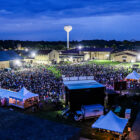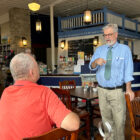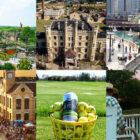by Nancy Uznanski
Named the McCormick Bridgehouse and Chicago River Museum, it is located in a handsome Bridgetower on the Southwest corner of Michigan Avenue and Wacker Drive. Opened in 2006 by the Friends of the Chicago River (Friends), its entrance is at 99 Chicago Riverwalk, next to the Chicago River and a level below the hustle and bustle of traffic on city streets.
“We are a museum dedicated to telling the story of the Chicago River System and its watershed from pre-colonization to the modern day, plus the history of the bridges that open along the river,” said Josh Coles, Museum Director.
“The City of Chicago offered an opportunity to lease the building to the Friends,” said Friends Executive Director Margaret Frisbie.
Since 1979, when they organized, Friends has been dedicated to helping bring the once heavily polluted river back to health. Frisbie said they have accomplished a lot. While running their own monthly programs and activities, they work alongside other organizations and government agencies, including the Metropolitan Water Reclamation District of Greater Chicago (MWRD),
“They are an ecologically based group, cleaning up and supporting the Chicago River,” said Ana B. Koval, President CEO Canal Corridor Association.
“We are the only group solely dedicated to the Chicago River System,” Frisbie said. “Our purpose is to work to improve the health of the Chicago and Calumet River for the benefit of people and wildlife, and we care for the full 156 miles of the system.”
Friends has always done and still does monthly cleanups along the rivers, she said. They remove litter before it gets into the streams, plant native grasses and other vegetation to reduce storm water runoff and erosion, and recreate wildlife habitats. They even put fencing around some riverside trees now to protect them from the reviving beaver population.
“In 1979 the river system was still so polluted that there were only about seven species of fish still struggling to survive in its waters. By 2006, when the museumopened that number was coming up. Today there are nearly 80 species living in the river and the wildlife habitat is coming back too,” Frisbie said. “Thousands of individuals have helped.”
Noting that the museum brings interest in the group, she added that accomplishments by Friends and the MWRD had already created enough change in the river’s health between 2006 and 2018, to update the museum displays.
“They did a complete exhibit rewrite and upgrade,” Koval said.
“Through the displays, which range from pre-colonization to looking to the future, people develop a new understanding of the Chicago River and the river system here,” Coles said. “We are Friends most forward facing program. We’ve had over 300 thousand people come though the museum since we opened. Many come because they are just enjoying the River and the Riverwalk.”
A large number arrive believing the river is as polluted as it was a hundred years ago. Then as they learn about the work of the Friends and others, they recognize the positive change they have made, he said.
Their introduction to the river includes excerpts taken from journals that give first-hand accounts of early river life, from wildlife including black bear and rattle snakes that lived in the area, to traders slogging through ‘Mud Lake’ portage with canoes on their shoulders.
As you continue upward through five floors, you learn about the effect the historic Illinois and Michigan (I&M) Canal National Heritage Corridor had on the river through trade from the Great Lakes to the Gulf of Mexico and beyond.
One can also see how the Chicago shoreline changed as thepopulation exploded. It went from about 400 in 1830 to nearly 300,000 in 1870, Coles said. You will also learn about health problems that came from such rapid development and how they were solved. Then on the top floor, a look to the future is revealed.
The Bridgehouse also shares another opportunity people love. It is the secret of how the leaves of the bridges over the river are opened and closed. Coles said the museum itself is a lookalike Bridgehouse completed in 1920 to match a working one across from it. There are four altogether, two working and two look-a-likes, built when the city felt it was important to build symmetrical structures.
“People think it’s cool because they can walk inside the bridge and watch the gears that operate it,” Coles added. “The leaves of the bridge are raised for boat traffic about eight weekends each spring and fall. You can hear and see the giant pieces of equipment that are more than 100 years old move, and the counter weights drop from just feet away. It is fascinating!”
The museum is open from early May to late October each year and Coles says to come and check it out.
“Visitors leave with a new appreciation and understanding of the Chicago River. Even if they don’t live in the area, they take that appreciation home with them,” he added.
Nancy Uznanski is a freelance writer.





